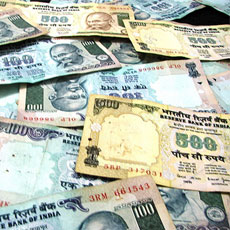by Vani Viswanathan
[box] Call it foreign-return-high-handedness or ex-NRI ramblings, Vani Viswanathan opens up on first thoughts about money she has come across in her three months since returning to India. [/box]Dollars -><- Rupees
You know what I mean – first time abroad, there you are converting everything to Rupees to determine whether you’d dare part with your dollars for it. Victim of the same, it took me some time to get over the fact that I have to pay $2 for lime juice even if that meant 50 Indian rupees that I would never dream of giving in India for juice. I however enjoyed going into a shop and finding things that cost less than one unit of any spending currency that wasn’t a toffee. I joyously bought a box of paper clips that cost 65 cents – stationery freak that I am, the cost of the box was only second to the pretty coloured clips and the box that they were in – and it’s such a prized possession because it was among the very first things I ever bought in Singapore and it’s come back with me to India after all these years too.
Victim of the same, it took me some time to get over the fact that I have to pay $2 for lime juice even if that meant 50 Indian rupees that I would never dream of giving in India for juice. I however enjoyed going into a shop and finding things that cost less than one unit of any spending currency that wasn’t a toffee. I joyously bought a box of paper clips that cost 65 cents – stationery freak that I am, the cost of the box was only second to the pretty coloured clips and the box that they were in – and it’s such a prized possession because it was among the very first things I ever bought in Singapore and it’s come back with me to India after all these years too.
Of course, this changed over time, and as I started earning, I enjoyed coming back and buying loads of books and tops from FabIndia only to happily bask in the fact that I barely spent $150. The line constantly running in my head was ‘For $80, I’d probably only have bought two tops in Singapore!’
Alas, those good days are over with my decision to return to India to be a student. And now, how much ever I try, I’m tempted to convert the price of clothes, books and food to Singapore Dollars and revel in the thought that it’s not much and is totally worth it – until I sadly remember the inflow in dollars isn’t coming anymore.
This costs this much?!
One of Spark’s contributors, Parth Pandya, had written in his article ‘Non Resident India’ in August 2011 about how many Indians are caught in the time warp of India that existed before they left the country, and I had told him how much I could associate with it. It is strange. Of course, I had been visiting India regularly while I was overseas, but somehow not spending out of your own pocket (and not earning anymore!) makes a big difference. Back now, I was initially jumping at the cost of everything ranging from juice to bread to milk, still stuck in the same amounts I remember from my high school days. I gulp at the thought of paying 80 rupees for Chhole Bhatura (and 90 bucks for Orange juice at Bangalore, those guys are ridiculous!), remembering those days when our rare excursions to a restaurant would see us paying 35 bucks for a full saapadu (meal). Yes, inflation, yes, people are earning more, but prices can’t quadruple in eight years’ time!!
Dirty Money
Have you ever noticed the number of creases an Indian ten or fifty rupee note has? The note, folded maybe up to four times, sits in the pocket of an auto driver, the drawstring bag of the vegetable seller, and in the plush wallets of, err, young people. Why the auto driver and vegetable seller fold the notes I can understand, but I gave some unsolicited advice (and not in too polite a tone, may I add) to a good friend as to why she shouldn’t fold her notes and keep them in her wallet, my undertone indicating that’s something an uneducated person would do. It was only when she gave her wide-eyed-‘Sorry’-why-do-I-deserve-this-rant look that I realized we hardly do it that way here. Notes are not spread out and kept neatly by anyone even with a wallet. Some of them are filthy beyond imagination; I remember reading a piece on how many kinds of germs spread through dirty notes, and looking at the ones here, I’m tempted to do an NRI and wash my hands thoroughly after a dirty-note transaction. I long for those days with the crisp plastic Singaporean dollars that just slide through your fingers. I think it’s a good idea to have plastic notes – they can’t be folded unless you try really hard.
What money costs
It’s interesting how the 50 paisa has no value, the one rupee is getting there (the auto driver won’t think twice about giving me one rupee less but won’t accept if I give a 10 instead of 11!), and 50 is the new 20. Spending 75 bucks on large fries seems criminal when I think of the innumerable things that 75 can buy elsewhere; somehow the 2.5 dollars that they used to cost in Singapore didn’t seem to have that much value.
What money means
 The biggest lesson I’ve learnt is how much money means to people here – and not just to those who don’t have it. Yes, world over everyone wants money, but the proportions I see here are just staggering. Refusing to pay a bribe for the police verification for my tenancy agreement and asking for a receipt for the thousands I shell out each month for my rent, I have managed to enrage my landlord to the extent he woke me up at 8 AM on a Saturday morning and asked me to pack my bags and vacate for ‘instigating’ the others in my house to not comply with his ‘rules’. ‘This is not Singapore,’ I hear for any question I ask, so much so that I’ve resigned to my fate in order to not get evicted or yelled at. Rent agreements have the word ‘Leave’ instead of ‘Lease’ to avoid additional taxation. We’re mired in so many ways to save money and get things done in ways out of the rule book. It’s upsetting that we have anti-corruption movements pinning the politicians as the sole perpetrators of corruption, but when we promote it endlessly ourselves, who are we to even raise a finger to blame? Ah, Money, Money, Money, making the world go around! What all you can do to people!
The biggest lesson I’ve learnt is how much money means to people here – and not just to those who don’t have it. Yes, world over everyone wants money, but the proportions I see here are just staggering. Refusing to pay a bribe for the police verification for my tenancy agreement and asking for a receipt for the thousands I shell out each month for my rent, I have managed to enrage my landlord to the extent he woke me up at 8 AM on a Saturday morning and asked me to pack my bags and vacate for ‘instigating’ the others in my house to not comply with his ‘rules’. ‘This is not Singapore,’ I hear for any question I ask, so much so that I’ve resigned to my fate in order to not get evicted or yelled at. Rent agreements have the word ‘Leave’ instead of ‘Lease’ to avoid additional taxation. We’re mired in so many ways to save money and get things done in ways out of the rule book. It’s upsetting that we have anti-corruption movements pinning the politicians as the sole perpetrators of corruption, but when we promote it endlessly ourselves, who are we to even raise a finger to blame? Ah, Money, Money, Money, making the world go around! What all you can do to people!
Vani Viswanathan is often lost in her world of books and A R Rahman, churning out lines in her head or humming a song. Her world is one of frivolity, optimism, quietude and general chilled-ness, where there is always place for outbursts of laughter, bouts of silence, chocolate, ice cream and lots of books and endless iTunes playlists from all over the world. Vani was a Public Relations consultant in Singapore and decided enough is enough with the struggle to find veggie food everyday, and returned to India after seven long years away. Vani blogs athttp://chennaigalwrites.blogspot.com
[button link=” https://sparkthemagazine.com/wp-content/uploads/2011/09/Spark-Sep2011.pdf” color=”red” newwindow=”yes”] Click here to download the September 2011 issue as a PDF.[/button] [button link=”http://issuu.com/sparkeditor/docs/spark-sep2011?mode=embed&layout=http%3A%2F%2Fskin.issuu.com%2Fv%2Fcolor%2Flayout.xml&backgroundColor=000000&showFlipBtn=true” color=”green” newwindow=”yes”] Click here to flip and read the issue like a magazine.[/button]
[facebook]share[/facebook] [retweet]tweet[/retweet]








